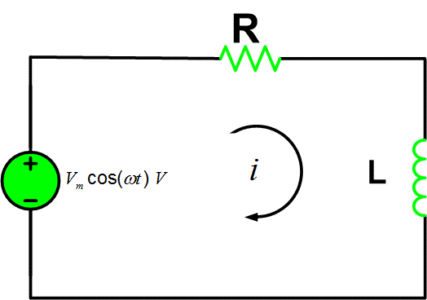The phasor method of analyzing circuits is credited generally to Charles Steinmetz, a famous electrical engineer with the General Electric Company in the early part of this century.
To begin, let us recall the general sinusoidal voltage,
$\begin{matrix} v={{V}_{m}}\cos (\omega t+\theta ) & \cdots & (1) \\\end{matrix}$
If the frequency ω is known, then v is completely specified by its amplitude Vm and its phase θ. These quantities are displayed in a related complex number,
$\begin{matrix} \text{V}={{V}_{m}}{{e}^{j\theta }}={{V}_{m}}\angle \theta & \cdots & (2) \\\end{matrix}$
Which is defined as a phasor, or phasor representation. To distinguish them from other complex numbers, phasors are printed in boldface type.
The motivation for the phasor definition may be seen from the equivalence, by Euler’s Formula, of
$\begin{matrix} {{V}_{m}}\cos (\omega t+\theta )=\operatorname{Re}({{V}_{m}}{{e}^{j\theta }}{{e}^{j\omega t}}) & \cdots & (3) \\\end{matrix}$
Therefore, in view of (1) and (2), we have
$\begin{matrix} v=\operatorname{Re}(\text{V}{{e}^{j\omega t}}) & \cdots & (4) \\\end{matrix}$
As an example, suppose we have
$v=10\cos (4t+{{30}^{o}})V$
The phasor representation is then
$\text{V}=10\angle {{30}^{o}}V$
Since Vm=10 and θ=30o. Conversely, since ω=4rad/s is assumed to be known, v is readily obtained from V.
In an ideal fashion, we define the phasor representation of the time domain current
$\begin{matrix} i={{I}_{m}}\cos (\omega t+\phi ) & \cdots & (5) \\\end{matrix}$
To be
$\begin{matrix} \text{I}={{I}_{m}}{{e}^{j\phi }}={{I}_{m}}\angle \phi & \cdots & (6) \\\end{matrix}$
Thus if we know, for example, that ω=6 rad/s and that $I=2\angle {{15}^{o}}$A, then we have
$i=2\cos (6t+{{15}^{o}})A$
We have chosen to represent sinusoids and their related phasors on the basis of cosine functions, though we could have chosen sine functions just as easily. Therefore, if a function such as
$v=8\sin (3t+{{30}^{o}})$
Is given, we may change it to
$v=8\cos (3t+{{30}^{o}}-{{90}^{o}})=8\cos (3t-{{60}^{o}})$
Then the phasor representation is
$\text{V}=8\angle -{{60}^{o}}$
To see how the use of phasors can greatly shorten the work, let us consider the following simple RL Circuit and its describing equation as
Fig.1: RL Circuit
$\begin{matrix} L\frac{di}{dt}+Ri={{V}_{m}}\cos \omega t & \cdots & (7) \\\end{matrix}$
Replace the excitation (input or source) Vmcosωt by the complex forcing function
${{v}_{1}}={{V}_{m}}{{e}^{j\omega t}}$
Which may be written as
${{v}_{1}}=\text{V}{{e}^{j\omega t}}$
Since θ=0, and therefore $\text{V}={{V}_{m}}\angle 0={{V}_{m}}$ . Substituting this value and i=i1 into (7), we have
\[L\frac{d{{i}_{1}}}{dt}+R{{i}_{1}}=\text{V}{{e}^{j\omega t}}\]
Whose solution i1 is related to the real solution i by
$i=\operatorname{Re}({{i}_{1}})$
Next, trying
${{i}_{1}}=\text{I}{{e}^{j\omega t}}$
As a solution, we have
$j\omega L\text{I}{{e}^{j\omega t}}+R\text{I}{{e}^{j\omega t}}=\text{V}{{e}^{j\omega t}}$
Dividing out the factor ejωt, we have the phasor equation,
$\begin{matrix} j\omega L\text{I}+R\text{I}=\text{V} & \cdots & (8) \\\end{matrix}$
Therefore,
\[\text{I}=\frac{\text{V}}{R+j\omega L}=\frac{{{V}_{m}}}{\sqrt{{{R}^{2}}+{{\omega }^{2}}{{L}^{2}}}}\angle -{{\tan }^{-1}}\left( \frac{\omega L}{R} \right)\]
Substituting this value into the expression for i1, we have
\[{{i}_{1}}=\frac{{{V}_{m}}}{\sqrt{{{R}^{2}}+{{\omega }^{2}}{{L}^{2}}}}{{e}^{j\left( \omega t-{{\tan }^{-1}}\left( \frac{\omega L}{R} \right) \right)}}\]
Taking the real part, we have
$i={{i}_{f}}\text{ }\therefore (forced\text{ }response)$
In general, the real solutions are time-domain functions, and their phasors are frequency-domain functions; i.e., they are functions of the frequency ω. Thus to solve the time-domain problems, we may convert to phasors and solve the corresponding frequency-domain problems, which are generally much easier. Finally, we convert back to the time-domain by finding the time function from its phasor representation.
You May Also Read: Sinusoidal Waveform or Sine Wave in Electricity
